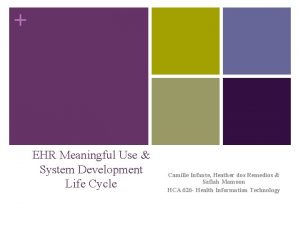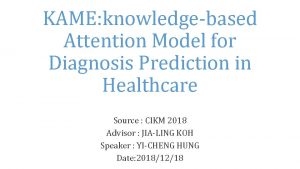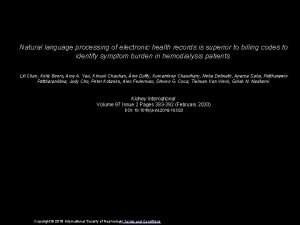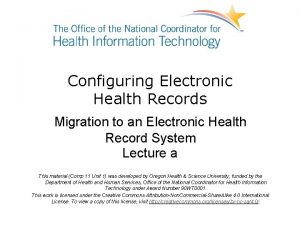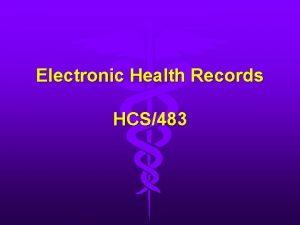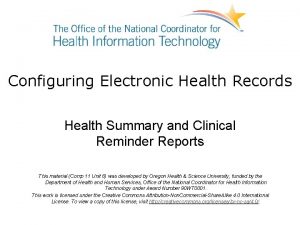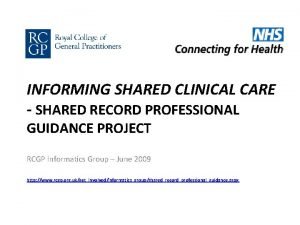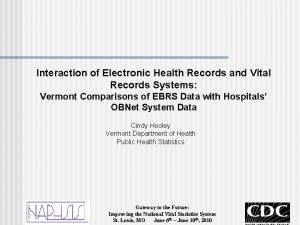Shared Longitudinal Health Records for Clinical and Population















- Slides: 15

Shared Longitudinal Health Records for Clinical and Population Health PERTEMUAN Ke - 10 Taufik Rendi Anggara. , MT Manajemen Informasi Kesehatan Fakultas Ilmu Kesehatan

LEARNING OBJECTIVES • Identify and describe the differences among an electronic medical record, electronic health record, and a shared heath record. • Explain the role of a shared health record in a health information exchange. • List and describe the components of a shared health record. • Discuss the role and benefits of a health management information system within a health information exchange. • Define a population health indicator. • Identify and describe application domains for a health management information system. • Define a database management system. • Compare the implications of implementing a shared health record using an electronic health record system versus a database management system. • Discuss emerging trends likely to shape the evolution of shared health records and health management information systems.

SHARED LONGITUDINAL RECORDS FOR CLINICAL HEALTH The Open. HIE model includes a component system called the shared health record (SHR) that compiles a longitudinal, person-centric record of a patient’s clinical encounters that are being shared among the organizations participating in HIE. The SHR system provides a permanent, centralized repository to store and manage the health information that are shared by the heterogeneous information systems of a regional or national health system. Contributing applications could include anything from a robust EMR system to a smallscale mobile application (recall the point-of-care applications from the model in the chapter: The Evolving Health Information Infrastructure). The SHR component of Open. HIE facilitates a variety of interactions between the internal components and external point-of-service applications with the goal of supporting the delivery of clinical care. The SHR enables pointof-service applications (eg, EMRs or pharmacy information systems) to store key clinical data such as a summary of care, laboratory test results, or vitals. The SHR can manage both structured data that is reconcilable with standard exchange formats (eg, discrete clinical observations) and unstructured data such as a digital image with associated patient information. Additionally, point-of-service systems can update existing patient records in the SHR with new information while preserving a version history.

SHARED LONGITUDINAL RECORDS FOR CLINICAL HEALTH The Open. HIE model includes a component system called the shared health record (SHR) that compiles a longitudinal, person-centric record of a patient’s clinical encounters that are being shared among the organizations participating in HIE. The SHR system provides a permanent, centralized repository to store and manage the health information that are shared by the heterogeneous information systems of a regional or national health system. Contributing applications could include anything from a robust EMR system to a smallscale mobile application (recall the point-of-care applications from the model in the chapter: The Evolving Health Information Infrastructure). The SHR component of Open. HIE facilitates a variety of interactions between the internal components and external point-of-service applications with the goal of supporting the delivery of clinical care. The SHR enables pointof-service applications (eg, EMRs or pharmacy information systems) to store key clinical data such as a summary of care, laboratory test results, or vitals. The SHR can manage both structured data that is reconcilable with standard exchange formats (eg, discrete clinical observations) and unstructured data such as a digital image with associated patient information. Additionally, point-of-service systems can update existing patient records in the SHR with new information while preserving a version history.

TABLE 10. 1 Common data Elements Included in a Shared Longitudinal Health Record

SHARED LONGITUDINAL RECORDS FOR POPULATION HEALTH In addition to improving the delivery of individual clinical care, sharing longitudinal health records also cultivates opportunities to improve health outcomes at the population level. The Open. HIE model contains a component called the Health Management Information System (HMIS) that stores and distributes cumulative population level information. The HMIS primarily supports management or administration of a health system, and it contains a wide range of aggregate level data. The HMIS aggregates individual clinical records that are shared within an HIE in order to provide indicators that characterize the health of the underlying population at the provider, facility, state, or national level. In addition, the HMIS should contain data on human resource distribution, population figures, service availability, and service quality such as the efficiency of the supply chain. This opens up for added value analysis of the aggregated clinical data. The information in the HMIS is available for reporting purposes and is intended to improve the administration and development of public health programs rather than the delivery of clinical care. Aggregated health information can benefit the health of a society by enhancing surveillance capacities, promoting advancements in medical research, and supporting the development of effective health policies.

SHARED LONGITUDINAL RECORDS FOR POPULATION HEALTH Dashboard of Indicators The aggregation of individual clinical records through the HMIS component of Open. HIE provides a dashboard of health indicators that can improve understanding of community health status. A health indicator is a metric that is routinely reported to provide insight into the characteristics of a population or the performance of a program. An accurate assessment of the current health status of the population and influential factors within the community is essential for elevating the overall health of the community. Important health indicators may constitute clinical outcomes (eg, mortality rates for cancer) or the prevalence of important health risk factors such as obesity or smoking. These health indicators can be leveraged to drive public health action such as policy changes or interventions to address significant health issues [15]. Programs such as Healthy People 2020 use health indicators to help direct their agendas. Aggregated health indicators allow Healthy People 2020 and other programs to identify crucial public health issues (eg, increasing prevalence of cardiovascular disease), institute goals for improving the issue (eg, reduce the mortality rate for cardiovascular diseases by 15% within 10 years), and then evaluate progress toward those goals (eg, compare the baseline mortality rate to the current mortality rate).

Cont. Disease Surveillance Recent threats to population health globally, including Ebola Virus (EBV), influenza (H 1 N 1), Middle East Respiratory Syndrome (MERSCo. V), and severe acute respiratory syndrome (SARS), illustrate the importance of building capacities within countries to detect the presence of infectious diseases at an early stage of an outbreak. Compiling information from individual clinical records can provide insight into the patterns and trends of disease throughout a population. Integrating the information from the SHR and HMIS systems with traditional surveillance strategies, such as vital records reports, can provide a more complete picture of the prevalence and spatial distribution of important diseases. Electronic, shared health records also offer the opportunity to conduct disease surveillance in real-time. Clinical information in the SHR can potentially be actively monitored for symptoms that may indicate the emergence of important diseases rather than waiting for confirmation through test results. Real-time information about disease trends increases the capability of public health organizations to detect emerging outbreaks at an early stage and implement appropriate control measures before the disease becomes widespread. Capabilities that can integrate and monitor emerging patterns of disease would be transformative to public health surveillance practice.

Cont. Medical Research Available, semantically interoperable information contained in the SHR and HMIS could be leveraged to advance medical research. Analysis of the cumulative clinical data that is available in the HMIS can be especially useful for the generation of hypotheses and when performing comparative assessments. Currently, population health in the United States is predominantly assessed through nationally funded health surveys such as the National Health Interview Survey (NHIS). The information collected in these surveys is self-reported, and may be unreliable or lack critical information. Incorporating the cumulative information from the HMIS that was collected as a part of routine care can complement and strengthen the value of existing data sources. SHRs also have the potential to identify eligible participants for clinical trials. Clinical trial participants have traditionally been recruited through advertisements, notices, or contacting physicians. An SHR system can be designed to simplify the process by adding optional alerts that can be relayed to candidates eligible for clinical trials by their physicians. The Indiana Health Information Exchange, described in “The Indiana Health Information Exchange”, is the only HIE known to routinely leverage its SHR for study recruitment, observational research, and comparative analyses.

IMPLEMENTATION SHR Implemented as an HER The Open. HIE model implements the SHR system as an independent component within a larger infrastructure. The interoperability layer (IL; described in the chapter: The Evolving Health Information Infrastructure) receives transactions from the disparate point-of-service systems exchanging information and facilitates the interaction between the internal components of the HIE. The Open. HIE infrastructure includes client registry (see the chapter: Client Registries: Identifying and Linking Patients), health worker registry (see the chapter: Health Worker Registries: Managing the Health-Care Workforce), and facility registry (see the chapter: Facility Registries: Metadata for Where Care Is Delivered) components to verify that the patients, providers, and facilities involved in a transaction request are known to the HIE. A complete shared record must also reconcile the unique terminologies and coding used by different point-of-service applications interacting with the HIE. The Open. HIE uses a terminology service to map local codes to the standardized internal format (see the chapter: Standardizing Healthcare Data Across an Enterprise).

FIGURE 10. 1 Architectural representation of the components of the shared health record as they could be implemented using the Open. MRS software

Cont. SHR Implemented as a Database An RDBMS model manages a database by allowing users to define and ascertain relationships between multiple tables within a repository. A standard language called Structured Query Language (SQL) is used to communicate with and manipulate the database [27, 28]. SQL allows users to perform complex queries and analysis with relatively basic syntax [28]. A relational database has tables that consist of rows that represent records and columns that contain descriptive characteristics such as heart rate, age, or gender. Assigning a unique identifier to each row enables the table to be linked to rows from other tables in the database that share the same identifier. For example, if a researcher needed to combine a table that contained patient heights with a table that contained patient weights in order to calculate BMI, an SQL statement could be written to link the two tables together by matching the unique patient identifier from each table.

Cont. HMIS Implemented as Data Analysis Platform The implementation of an HMIS system within an HIE requires the standardization of indicators, an appropriate software platform, and methods of collecting and evaluating the quality of the data from a variety of sources. The indicators included in the HMIS must be standardized to facilitate meaningful comparison across health facilities and geographic areas. Indicator definitions and codes must be consistent throughout the HIE to enable interoperability between the systems exchanging health information. There should also be cohesion of the aggregated data from the facility level on up to the national level. A challenge facing HMIS/EHR interoperability is the lack of development of mature data exchange standards in this domain—certainly in comparison with other domains of HIE. In 2009, the World Health Organization (WHO) led an effort to develop a standard called SDMX-HD for representing indicators and aggregate datasets aimed primarily at global health reporting. The SDMX-HD standard never saw significant uptake.

Cont. Data Quality Challenges to Implementation In order for the HMIS to provide a reliable method of measuring population health outcomes and evaluating the performance of public health programs and policies, it is critical that data quality is assessed effectively. A high degree of data quality can be attained by regulating processes, identifying the underlying sources of errors, and correcting processes to eliminate failures. A quality assessment should consider the data itself, the use of the data, and the collection process [34]. Many healthcare organizations have adopted a total quality management (TQM) approach to consistently improve the quality of their data. The TQM approach pursues quality improvement through the continuous refinement of existing systems and processes based on evaluations and feedback. While originally used in the business sector, recent work has adapted it for use in health care.

SUMMARY Patient care is a multifaceted process that can involve a range of tasks such as personal consultations, blood tests, and X-rays. As a result, clinical data are collected in many different formats including structured observations, image documents, transcribed notes, or laboratory results. This information often resides in numerous heterogeneous information systems. The ability to successfully assemble the data that are stored in disparate formats and systems into a single, integrated and longitudinal patient health record can benefit the individual patient, the healthcare organizations participating in the HIE, and the community as a whole. An SHR simplifies interoperability between information systems by providing a centralized repository that stores the information moving throughout the HIE in order to improve the quality and efficiency of clinical care. Shared, longitudinal health records can also be aggregated at the population level through systems such as the Open. HIE HMIS, and subsequently distributed through an HIE to promote the advancement of community health outcomes through policy changes, surveillance, and research.
 Longitudinal health record
Longitudinal health record Chapter test a chapter 4 population ecology answer key
Chapter test a chapter 4 population ecology answer key Section 1 population dynamics
Section 1 population dynamics Population ecology section 1 population dynamics
Population ecology section 1 population dynamics Chapter 4 population ecology answer key
Chapter 4 population ecology answer key Electronic health records pros and cons
Electronic health records pros and cons Administrative information systems definition
Administrative information systems definition System development life cycle of electronic health records
System development life cycle of electronic health records Electronic health records
Electronic health records Language
Language +electronic +health +records +migration
+electronic +health +records +migration Population health risk assessment and management
Population health risk assessment and management Chapter 2 population and health key issue 3
Chapter 2 population and health key issue 3 Compression and rarefaction
Compression and rarefaction Example of longitudinal wave
Example of longitudinal wave Whole health clinical group
Whole health clinical group







